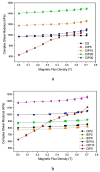Recent Progress in Isotropic Magnetorheological Elastomers and Their Properties: A Review
- PMID: 33348727
- PMCID: PMC7766993
- DOI: 10.3390/polym12123023
Recent Progress in Isotropic Magnetorheological Elastomers and Their Properties: A Review
Abstract
Magnetorheological elastomers (MREs) are magneto-sensitive smart materials, widely used in various applications, i.e., construction, automotive, electrics, electronics, medical, minimally invasive surgery, and robotics. Such a wide field of applications is due to their superior properties, including morphological, dynamic mechanical, magnetorheological, thermal, friction and wear, and complex torsional properties. The objective of this review is to provide a comprehensive review of the recent progress in isotropic MREs, with the main focus on their properties. We first present the background and introduction of the isotropic MREs. Then, the preparation of filler particles, fabrication methods of isotropic MREs, and key parameters of the fabrication process-including types of polymer matrices and filler particles, filler particles size and volume fraction, additives, curing time/temperature, and magnetic field strength-are discussed in a separate section. Additionally, the properties of various isotropic MREs, under specific magnetic field strength and tensile, compressive, or shear loading conditions, are reviewed in detail. The current review concludes with a summary of the properties of isotropic MREs, highlights unexplored research areas in isotropic MREs, and provides an outlook of the future opportunities of this innovative field.
Keywords: carbonyl iron particles; construction and medical applications; magneto-sensitive smart materials; magnetorheological elastomers (MRE); rheological properties.
Conflict of interest statement
The authors declare no conflict of interest.
Figures






















Similar articles
-
The Magneto-Mechanical Hyperelastic Property of Isotropic Magnetorheological Elastomers with Hybrid-Size Magnetic Particles.Materials (Basel). 2023 Nov 23;16(23):7282. doi: 10.3390/ma16237282. Materials (Basel). 2023. PMID: 38068026 Free PMC article.
-
Effect of Carbonyl Iron Particle Types on the Structure and Performance of Magnetorheological Elastomers: A Frequency and Strain Dependent Study.Polymers (Basel). 2022 Oct 6;14(19):4193. doi: 10.3390/polym14194193. Polymers (Basel). 2022. PMID: 36236145 Free PMC article.
-
Mechanical Properties Comparison of Isotropic vs. Anisotropic Hybrid Magnetorheological Elastomer-Fluid.Polymers (Basel). 2024 Apr 26;16(9):1215. doi: 10.3390/polym16091215. Polymers (Basel). 2024. PMID: 38732684 Free PMC article.
-
Magnetorheological Elastomers: Fabrication, Characteristics, and Applications.Materials (Basel). 2020 Oct 15;13(20):4597. doi: 10.3390/ma13204597. Materials (Basel). 2020. PMID: 33076562 Free PMC article. Review.
-
Dynamic Behavior of Sandwich Structures with Magnetorheological Elastomer: A Review.Materials (Basel). 2021 Nov 19;14(22):7025. doi: 10.3390/ma14227025. Materials (Basel). 2021. PMID: 34832428 Free PMC article. Review.
Cited by
-
The effect of polymer stiffness on magnetization reversal of magnetorheological elastomers.APL Mater. 2022 Apr;10(4):041106. doi: 10.1063/5.0086761. Epub 2022 Apr 13. APL Mater. 2022. PMID: 36861033 Free PMC article.
-
An experimental study of tuned liquid column damper controlled multi-degree of freedom structure subject to harmonic and seismic excitations.PLoS One. 2022 Jun 13;17(6):e0269910. doi: 10.1371/journal.pone.0269910. eCollection 2022. PLoS One. 2022. PMID: 35696409 Free PMC article.
-
Dynamic Behavior Modeling of Natural-Rubber/Polybutadiene-Rubber-Based Hybrid Magnetorheological Elastomer Sandwich Composite Structures.Polymers (Basel). 2023 Nov 30;15(23):4583. doi: 10.3390/polym15234583. Polymers (Basel). 2023. PMID: 38232007 Free PMC article.
-
Shape-Memory Polymers Based on Carbon Nanotube Composites.Micromachines (Basel). 2024 Jun 1;15(6):748. doi: 10.3390/mi15060748. Micromachines (Basel). 2024. PMID: 38930718 Free PMC article. Review.
-
Effect of Volume Fraction on Shear Mode Properties of Fe-Co and Fe-Ni Filled Magneto-Rheological Elastomers.Polymers (Basel). 2022 Jul 21;14(14):2968. doi: 10.3390/polym14142968. Polymers (Basel). 2022. PMID: 35890744 Free PMC article.
References
-
- Surbhi, Sukesha Response of piezoelectric materials to the external temperature, electric field and humidity. Mater. Today Proc. 2020;28:1951–1954. doi: 10.1016/j.matpr.2020.05.555. - DOI
-
- Usman M., Hanif A., Kim I.H., Jung H.J. Experimental validation of a novel piezoelectric energy harvesting system employing wake galloping phenomenon for a broad wind spectrum. Energy. 2018;153:882–889. doi: 10.1016/j.energy.2018.04.109. - DOI
-
- Bahmani A., Li G., Willett T.L., Montesano J. Generating realistic representative microstructure of biomimetic composite materials for computational assessment of mechanical properties. Mater. Today Proc. 2019;7:373–381. doi: 10.1016/j.matpr.2018.11.098. - DOI
-
- Carotenuto G., La Peruta G., Nicolais L. Thermo-chromic materials based on polymer-embedded silver clusters. Sensors Actuators B. 2006;114:1092–1095. doi: 10.1016/j.snb.2005.07.044. - DOI
-
- Yuan X., Zhou X., Liang Y., Wang L., Chen R., Zhang M., Pu H., Xuan S., Wu J., Wen W. A stable high-performance isotropic electrorheological elastomer towards controllable and reversible circular motion. Compos. Part B. 2020;193:107988. doi: 10.1016/j.compositesb.2020.107988. - DOI
Publication types
Grants and funding
LinkOut - more resources
Full Text Sources

